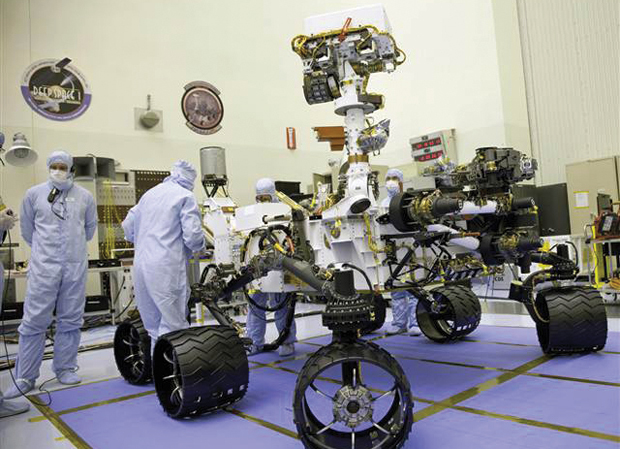
MISSION ON MARS. The Curiosity rover is expected to greatly contribute to ongoing studies on the habitability of Mars by NASA’s Mars Science Laboratory. Photo from NASA.
ON NOVEMBER 26, 2011, the United States’ National Aeronautics and Space Administration (NASA) launched Curiosity, the Mars rover, at 7:02 AM Pacific Standard Time, with its mission to determine the possibility of life on the “Red Planet.” It landed on Mars last August 5 at 10:32 PM Pacific Daylight Time.
According to NASA, the duration of the mission will be one Mars year, or about 23 months on Earth.
Red is in
“Scientists entertain the hope to colonize Mars and build a new human civilization out there,” said Quirino Sugon Jr, PhD, Physics Department assistant professor and Iono-Geomagnetics program coordinator for the Manila Observatory.
In line with this, senior physics and materials science and engineering major Josh Uy said, “One theory is that Mars may be a sort of template for the Earth—that by studying Mars’ past, we can get a glimpse as to where our planet is heading.” He added that this also suggests that Mars can be a second home that sustains life like the Earth. However, he noted that this theory is “very ideal” because the surface on Mars is inhabitable.
Meanwhile, Engineer Gian Mayuga from the Electronics, Computer and Communications Engineering Department, who also works on a similar project called Eye-C, said, “The mere fact that it was actually sent from Earth to Mars and is currently operational is definitely a success. The mere fact again that it is gathering data using its different and various functionalities such as cameras, arms, scientific payloads, and laser, and it is sending back the data to Earth is a greater success.”
He also said that this “brings a feeling that everything is interconnected, that even something so far can be so close.”
Watawat on Mars
The mission also shouts Filipino as 25-year-old Filipino-American Gregory Villar III is one of the youngest Operations Systems Engineer for the Mars Science Laboratory (MSL) Project.
“Gregory Villar III, being a part of the NASA Jet Propulsion Laboratory and part of the Mars Science Laboratory team, is an inspiration. I’m sure that this is a dream come true for him. As a fellow Filipino engineer, this is definitely something to be proud of,” Mayuga said.
The rover in 360 degrees
A fruit of NASA’s $2.5 billion MSL mission and weighing 899 kilograms, Curiosity has ten different science instruments which would aid it to serve its purpose—that is, to see whether Mars once hosted life on its surface.
Curiosity has the Mast Camera, which, with a speed of up to 90 meters per hour, is responsible for taking high-definition photos. It consists of two cameras that would rise above the rover’s main body. It also has a high-powered magnifying glass, the Mars Hand Lens Imager, which takes colored pictures up to 2.5 microns. This instrument is on the rover’s seven-foot robotic arm. The Mars Descent Imager, also on the main body, takes videos and provides geological information about its landing site.
Curiosity also contains the Sample Analysis at Mars acknowledged as the heart. It has three parts: mass spectrometer, a gas chromatograph and a laser spectrometer. These detect elements capable of producing life, such as carbon.
To identify and quantify these elements, the rover has the Chemistry and Mineralogy instrument which characterizes material taken by the rover. For the Martian rocks that are hard to reach, the rover has the Chemistry and Camera complex which shoots a laser as far as three feet and analyzes a rock’s composition.
At the back is the Dynamic Albedo of Neutrons, which casts out neutron beams on the ground to detect underground water or ice. The Alpha Particle X-ray Spectrometer, on the other hand, measures the abundance of chemical elements in different rocks and compositions.
A Radiation Assessment Detector measures the radiation and exposure of the planet to gamma rays which would contribute to the preparation for future exploration on Mars. The Rover Environmental Monitoring Station measures the planet’s weather and different atmospheric behaviors.
Asking for more
With Curiosity landing on Mars, will questions finally be answered?
With the possibility of life beyond Earth explored, Mayuga further stressed that “the opposite should be asked: did life start elsewhere and Earth is a byproduct? Scientists should ask both.”
For Uy, “the answer lies in the name of the rover itself—Curiosity. That is the driving force of science and discoveries. The answer may not be clear to us now what sort of significance the findings may bring. But at least, we dared ask and dared to move towards a better answer.”



